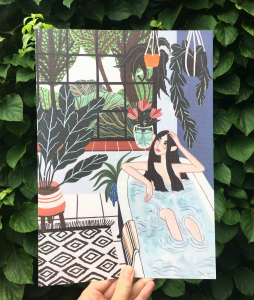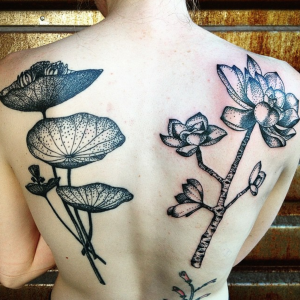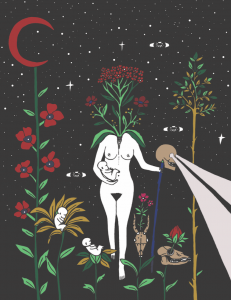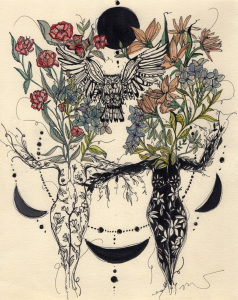For reasons that are just now becoming conscious for me, I have been steeping myself in wildness more than ever. And because of that, I’ve begun to notice that many others are doing the same. It’s as though nature is finally managing to vine its way back into many of our lives.
When I use the word wildness, I mean that which exists in parallel to our lives: plants that grow in cracks in our sidewalks and at the edges of our yards, the coyotes that come down into urban neighborhoods from the Santa Monica Mountains, and, of course, the night sky. These things are not separate from or unaffected by us, and yet they have this entire existence onto themselves that we typically know very little about. Like the body, where we can look for some of the clearest and simplest information, the wildness of nature offers us tremendous wisdom.
My re-acquaintance with wildness seems to have begun through gardening. More and more plants are showing up in my yard, in my home, and in my office. My clients can certainly attest to this change, which became especially apparent when a tree in a twenty gallon pot appeared atop my filing cabinet. I’ve realized that this shift in me is in direct response to what I’m seeing happen in the states and on our planet in general. It’s a place to put my care and attention that’s both needed and well-received. As a fellow therapist in my office building said, “My garden has never been so free of weeds as it is under this administration.”
It can be difficult to articulate the ways in which interacting with wildness is good for the psyche, partly because the gifts are simultaneously simple and vast, but especially because it’s such a felt experience. That in itself is a huge part of why it’s important; it’s embodied. It requires us to be present, to be tuned in, to be hands-on. We have to be aware of ourselves, the space we take up, and the impact we have. With gardening in particular, we must be committed witnesses who take action on what we see. We have to experiment to find the right course of action. Sometimes we have to be patient as a process unfolds. And all of this gets to happen alongside enjoying the beauty, oxygen, medicine, and food that plants have to offer.
With the intention of finding more words for some of these felt experiences, I just took a pause from writing to go outside for a little gardening, and was reminded of a major component of tending to the earth. It’s humbling. I have two passion fruit plants, which I sprouted from the seeds of a few fruits that I ate last year. They grow rather slowly, but just recently have begun to really look like plants. After over a year of tending to them, it’s been very rewarding to see that, and to imagine that soon they’ll begin to vine up the fence I placed them near. I’ve been wondering how many years it’ll be before they produce fruit, and have imagined how special it will be to finally eat one. Last week I noticed a caterpillar munching on one of the plants, so I moved it as politely as possible. Just now when I went out to transplant something nearby, I saw that one of the two plants was completely eaten, and that my caterpillar friends (of which there are now four) have begun on the other. Therein lies the challenge that brings humility. Do I keep fighting the caterpillars? Do I kill them? That’s an easy no for me; I made a commitment some time ago to avoid killing other creatures, unless my health or safety would definitely be affected otherwise. Fortunately those moments are blessedly rare, and that was very important to discover. We so often approach situations with a zero sum mentality when in actuality, nature rarely works that way. When we give to it, it gives to us. We just don’t always get to choose exactly what we get back. So it comes down to: do I want passion fruit, butterflies, or to plant more of something or other that the caterpillars might focus on instead? I’m going with the butterflies. And chances are I’ll get to see them cocooning somewhere nearby and I’ll get to witness their growth instead of that of my plants. Seems like a pretty fair deal to me. In this way, gardening is both self-care and activism. I get to grow and so do plants.
It’s these sort of experiences that inform my way of looking at the world in general. If I always choose convenience, to prioritize my individual needs, or narrow-mindedly stick to my original plans despite receiving new information, I’m choosing a selfish and eventually destructive path. Selfishness accumulates and eventually it affects others before finally returning to us. That is what we’re seeing now. We’ve been selfish with ourselves, with each other, and in our relationship to Earth. It’s fairly clear what we’ve been getting wrong organizationally, but what we do on the large scale is but a macrocosm of what’s happening inside our hearts and heads.
So I find it very heartening to see what’s happening in two areas in particular: art and fashion trends. Now of course I know that as the curator of my own perusal of art, I’m likely seeing more wildness than is average. But it’s clear that earth-based elements have increased within popular culture. Plants are everywhere in our art. We’re bringing crystals and minerals into our homes in both old and new ways. Geometric shapes have dominated the furniture market for several years now. And the succulent craze has brought more plants into people’s lives than any other houseplant trend in the recent past. I’d offer that this might be rivaled by the macrame extravaganza of the ’60s and ’70s, but we’ve brought those back, too. Simple shapes, raw wood, brick, beautiful glass… we are surrounding ourselves with basic elements. We must need it. And just look at all of this grounding, evocative, nature-based work…
 “Bathing Beauty” by Rachael Dean
“Bathing Beauty” by Rachael Dean
 art and tattoo by Lisa Cardenas
art and tattoo by Lisa Cardenas
 “Mama Bird” by Racheal Rios
“Mama Bird” by Racheal Rios
 “eternal return” by MerakiLabbe/ Vanja Vukelic
“eternal return” by MerakiLabbe/ Vanja Vukelic
 “connected soul. spirit sisters” by Marcy Ellis
“connected soul. spirit sisters” by Marcy Ellis
Notice how many themes are repeated across the pieces: plants, intermingling, growth, the feminine, birth and death. I am most definitely a sucker for symbology, and know well through my studies and experiences what a profound impact it can have on our psyches. Notice how often heads are replaced by plants. I love what’s suggested by finding a plant where one would normally encounter the places where our thinking, seeing, and speaking originates. I won’t ruin it by over-defining it. Just ponder that. Feel into it.
My hope for this time is that this love for the natural world does not fade from us as trends do, that we understand how badly we need to make lifelong friends with nature and wildness, and that we incorporate this knowledge into our institutions in such a way that it cannot be lost again.